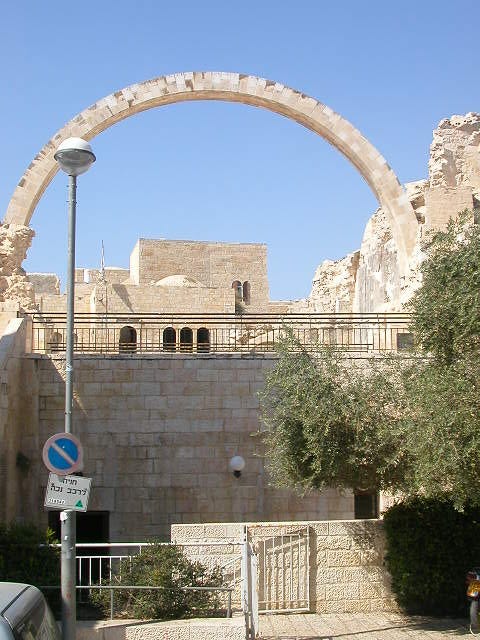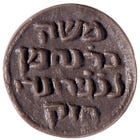Av 5784: Rebuilding Jerusalem - The Emblematic Case of the Ramban Synagogue
🕍 What we know—and don't know—about the famously renewed synagogue in the Jewish Quarter of that Old City, and what it tells us about rebuilding in the face of uncertainty and adversity.

Audio
Audio version here.
Hello, friends! It’s been longer than I planned. It turns out that everything they tell you about coming on aliyah with plenty of flexibility and a sense of humor is true. Despite our stuff arriving in Israel right on schedule, let’s just say it was a bit of a sipur (long story) to get to the point where I could type on anything higher than the floor. My new office, currently housed on our folding table that usually does its annual service in our sukkah, is in the upstairs mamad (safe room), which, guess what, won’t have decent internet for another two weeks when the type of wireless extender we need comes back in stock. But we make do, yes? And, G-d willing, in a day or two we’ll have more furniture and I’ll be able to unpack my books. So here I am, effectively book-less with spotty internet, blissfully writing to you again from the Land of Israel.
This post-October 7th Tisha be-Av was a difficult one. I struggled through it (spiritually speaking, though I also managed to get terrifically dehydrated) and I struggled with what I wanted to write about for Av. And, too, with the strangeness of being, finally and joyfully, in Eretz Yisrael on this somber day, with a beautiful, vibrant Jerusalem around the bend from here. I considered writing about Tu be-Av, which has a completely fascinating backstory, but I didn’t quite make it in time (next time!), and anyway it seemed to obviate a problem better faced. So instead I took inspiration from Jerusalem herself and give to you the knotty story of the Ramban synagogue in Jerusalem, which contains within it a story of destruction and renewal (many times over).
A Tale of Two Synagogues?
The building today identified as “the Ramban synagogue” stands in the Jewish Quarter of the Old City and is considered the oldest (rabbanite) synagogue in Jerusalem. There is ample testimony of it beginning in the fifteenth century, approximately 120 years after the Ramban’s lifetime. However, from before that, the historical record is less definitive. The source of the attribution to Ramban of the synagogue now known by his name comes from a letter penned by Ramban in Eretz Yisrael, to which he made aliyah in his seventies, on the heels of the persecutory friars who pressured the king of Aragon to compel him to participate in a public disputation. I wrote about the Ramban’s aliyah here:
In a letter to his son Nachman in Spain, Ramban writes from Jerusalem:
ומה אגיד לכם בענין הארץ, כי רבה העזובה וגדל השממון, וכללו של דבר, כל המקודש מחבירו חרב יותר מחבירו, ירושלים יותר חרבה מן הכל, וארץ יהודה יותר מן הגליל, ועם כל חרבנה היא טובה מאד, ויושביה קרוב לאלפים, ונוצרים בתוכם כשלש מאות, פליטים מחרב השולטן, ואין ישראל בתוכה, כי מעת באו התתרים ברחו משם, ומהם שנהרגו בחרבם, רק שני אחים צבעים קונים הצביעה מן המושל ואליהם יאספו עד מנין מתפללים בביתם בשבתות. והנה זרזנו אותם ומצאנו בית חרב בנוי בעמודי שיש וכיפה יפה ולקחנו אותו לבית הכנסת, כי העיר הפקר וכל הרוצה לזכות בחרבות זוכה, והתנדבנו לתיקון הבית, וכבר התחילו ושלחו לעיר שכם להביא משם ספרי תורה אשר היו מירושלים והבריחום שם בבוא התתרים, והנה יציבו בית הכנסת ושם יתפללו. כי רבים באים לירושלים תדיר אנשים ונשים מדמשק וצובה וכל גלילות הארץ לראות בית המקדש ולבכות עליו, ומי שזכנו לראות ירושלים בחרבנה, הוא יזכנו לראות בבנינה ותיקונה בשוב אליה כבוד השכינה.
What shall I say to you with regards to the Land, but that the neglect and emptiness is great. The operating rule is that that which is holier is subject to greater destruction than its less sanctified counterpart, and Jerusalem is thus more destroyed than all, and the land of Judea more than the Galil (Galilee). But for all its destruction it is exceedingly good, its inhabitants numbering close to two thousand, among them some three hundred Christians, refugees from the sultan’s sword; and there are no Jews within it, for at the coming of the Tatars they fled from there. From those that were killed by their swords, only two brothers who were painters [remained], who bought [the right to] paint from the ruler. A minyan (prayer quorum) would gather in their homes on Shabbat. And now we have strengthened them by finding a ruined building build with marble columns and a beautiful dome and making it into a synagogue—since the city is ownerless and and anyone who wants to assume a ruin does so. We volunteered to renovate the building, and as soon as they had begun, they dispatched [people] to the city of Shechem to bring from there Torah scrolls that had originated in Jerusalem but had been smuggled out to there at the coming of the Tatars. And so we founded a synagogue there and there the people pray, since there are many who come regularly to Jerusalem, both men and women, from Damascus and Tzova [Aleppo] and all the regions of the Land to see the [site of] the Beit ha-Mikdash and weep for it. One who merits to see Jerusalem in its destruction will also merit to see it in its rebuilt and rehabilitated state, when the glory of the Shechina will return to it.
Letter of Ramban to his son Nachman, in C. Chavel, ed. כתבי רמב”ן, vol. 1:347-348.
Keep reading with a 7-day free trial
Subscribe to Stories from Jewish History to keep reading this post and get 7 days of free access to the full post archives.



